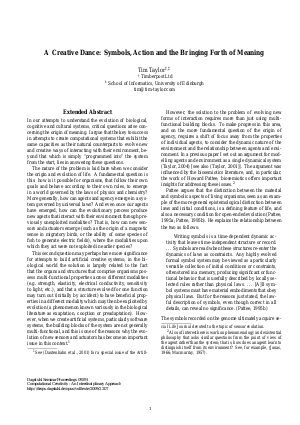A Creative Dance: Symbols, Action and the Bringing Forth of Meaning
Author Tim Taylor
-
Part of:
Volume:
Dagstuhl Seminar Proceedings, Volume 9291
Part of: Series: Dagstuhl Seminar Proceedings (DagSemProc) - License:
 Creative Commons Attribution 4.0 International license
Creative Commons Attribution 4.0 International license
- Publication Date: 2009-10-07
File

PDF
DagSemProc.09291.3.pdf
- Filesize: 59 kB
- 3 pages
Document Identifiers
Subject Classification
Keywords
- Computational creativity; origin of meaning; artifical life; evolution; biosemiotics
Metrics
- Access Statistics
-
Total Accesses (updated on a weekly basis)
0Document
0Metadata
Abstract
In our attempts to understand the evolution of biological, cognitive and cultural systems, critical questions arise concerning the origin of meaning. I argue that the key to success in attempts to create computational systems that exhibit the same capacities as their natural counterparts to evolve new and creative ways of interacting with their environment, beyond that which is simply “programmed into” the system from the start, lies in answering these questions. The nature of the problem is laid bare when we consider the origin and evolution of life. A fundamental question is this: how is it possible for organisms, that follow their own goals and behave according to their own rules, to emerge in a world governed by the laws of physics and chemistry? More generally, how can agents and agency emerge in a system governed by universal laws? And even once our agents have emerged, how can the evolutionary process produce new agents that interact with their environment through previously unexploited modalities? In this paper I describe work on a novel modelling approach which aims to solve these problems and thereby allow us to produce artificial evolutionary systems with greatly improved creative evolutionary potential. This perspective sees organisms as entities whose phenotypes are embedded within an environment viewed as a dynamical system, and whose genotypes interact with the environment by specifying constraints upon its dynamics, thereby generating the phenotypes. That is, the abiotic environment has its own dynamics and self-organisational properties; genotypes act to “sculpt” these pre-existing dynamics by supplying constraints. From this point of view, the most important distinction is not between organisms and their abiotic environment, but rather between the environment as a whole (including organism phenotypes) and organism genotypes. Elsewhere I have presented initial results from a model based upon this perspective, and demonstrated simple examples of the evolution of new sensors and effectors, and of genome-regulated self-stablising behaviour. Going further, we can generalise this perspective; in so doing, we may find useful connections and analogies between biological, cognitive and cultural systems, and thereby gain a better understanding of how creativity may be instilled into artificial systems. The generalised picture describes a situation in which the constraints of the system initiate dynamics, and the dynamics may feed back to affect (select or modify) the constraints. In a situation such as this, the system may exhibit behaviour which cannot be explained purely by the laws of dynamics, but only with reference to the particular history through which the system has evolved from its initial to current state. This mutual interaction (or “creative dance”) thereby brings forth novel forms of behaviour, the meaning of which can only be understood by considering how the dance itself has evolved over time. This general description could be applied to a variety of other systems, including the development of human cognitive processes, and the development of human cultural traditions, institutions and artefacts. Consideration of the extent to which such analogies hold between these very different systems, and the commonalities and differences between them, will surely lead to a much deeper understanding of the generative causes of novelty and creativity, and the origin of meaning, in natural systems. And such understanding will suggest ways in which we may create artificial systems with a much deeper capacity for creativity than exhibited by previous attempts.
Cite As Get BibTex
Tim Taylor. A Creative Dance: Symbols, Action and the Bringing Forth of Meaning. In Computational Creativity: An Interdisciplinary Approach. Dagstuhl Seminar Proceedings, Volume 9291, pp. 1-3, Schloss Dagstuhl – Leibniz-Zentrum für Informatik (2009)
https://doi.org/10.4230/DagSemProc.09291.3
BibTex
@InProceedings{taylor:DagSemProc.09291.3,
author = {Taylor, Tim},
title = {{A Creative Dance: Symbols, Action and the Bringing Forth of Meaning}},
booktitle = {Computational Creativity: An Interdisciplinary Approach},
pages = {1--3},
series = {Dagstuhl Seminar Proceedings (DagSemProc)},
ISSN = {1862-4405},
year = {2009},
volume = {9291},
editor = {Margaret Boden and Mark D'Inverno and Jon McCormack},
publisher = {Schloss Dagstuhl -- Leibniz-Zentrum f{\"u}r Informatik},
address = {Dagstuhl, Germany},
URL = {https://drops.dagstuhl.de/entities/document/10.4230/DagSemProc.09291.3},
URN = {urn:nbn:de:0030-drops-22072},
doi = {10.4230/DagSemProc.09291.3},
annote = {Keywords: Computational creativity; origin of meaning; artifical life; evolution; biosemiotics}
}
